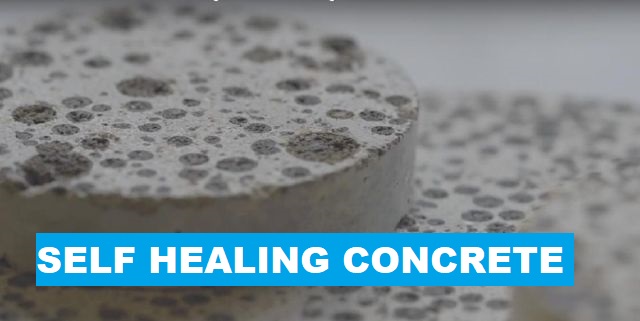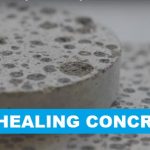When it comes to building materials, there’s no question that concrete is one of the most popular and widely used options available. Its strength and resilience make it ideal for a variety of construction projects, from bridges and roadways to homes and commercial buildings. However, despite its many benefits, concrete is not without its challenges. Exposure to harsh weather conditions, heavy loads, and other environmental factors can all take a toll on concrete structures, causing them to crack and break over time. This can lead to costly repairs and maintenance, not to mention safety concerns.
Fortunately, there’s a groundbreaking new technology that’s set to revolutionize the concrete industry: self-healing concrete. By leveraging cutting-edge techniques such as bacterial and encapsulation methods, this innovative approach initiates the healing process directly within the concrete matrix. The potential benefits for sustainability, durability, and reduced maintenance are massive, and this article provides a detailed overview of the self-healing concrete concept, how it works, and the many exciting applications it presents.
Understanding Self-Healing Concrete
Concrete is a widely used construction material due to its strength and durability. However, it is prone to cracking and damage over time, compromising its structural integrity and longevity. Traditional repair methods often involve patching or replacing the damaged areas, which can be costly, time-consuming, and disruptive to the functioning of structures.
To address this challenge, scientists and engineers have developed self-healing concrete as an innovative solution. Self-healing concrete incorporates unique properties and mechanisms that allow it to repair cracks and damage autonomously, without the need for human intervention. This technology is often referred to as “smart concrete” or “bio-concrete.”
The self-healing capability of concrete is achieved by incorporating healing agents or encapsulated bacteria within the concrete matrix during the mixing process. These agents remain dormant within the concrete until cracks form. Once cracks occur, they are triggered to activate and initiate the healing process.
The healing agents used in self-healing concrete can take different forms depending on the mechanism employed. One common approach is the use of microcapsules, which are tiny containers filled with healing agents such as polymers or adhesive materials. These microcapsules are dispersed throughout the concrete mixture during its production.
When cracks develop in the concrete, the microcapsules rupture or break open, releasing the healing agents into the vicinity of the cracks. The healing agents then come into contact with the surrounding environment, where they react and undergo chemical processes. These reactions lead to the formation of a self-repairing seal within the cracks, effectively closing them and restoring the structural integrity of the concrete.
Another mechanism used in self-healing concrete involves the incorporation of bacteria strains within the concrete matrix. These bacteria are selected for their ability to activate and thrive in the alkaline environment of concrete. Similar to microcapsules, the bacteria remain dormant within the concrete until cracks form.
When cracks occur, moisture and air penetrate the concrete, creating a conducive environment for the activation of the bacteria. The bacteria consume the nutrients present in the concrete, typically calcium lactate, and produce calcium carbonate as a byproduct. Calcium carbonate is a mineral compound that has cementitious properties and can fill the cracks, effectively sealing them and restoring the strength of the concrete.
The development of self-healing concrete has opened up new possibilities for the construction industry. By harnessing the inherent healing properties of the material, self-healing concrete offers improved durability and reduced maintenance requirements for concrete structures. It has the potential to significantly extend the lifespan of infrastructure, enhance structural safety, and reduce the environmental impact of repairs and replacements.
As research and development in the field of self-healing concrete continue to advance, there is optimism that this technology will become more widespread and cost-effective, leading to a future where structures can repair themselves, ensuring sustainable and resilient infrastructure for generations to come.
Mechanisms of Self-Healing Concrete
There are different mechanisms employed in self-healing concrete, each with its unique advantages. Two notable mechanisms are autonomous healing and bacteria-mediated healing:
- Autonomous Healing: In autonomous healing, microcapsules filled with healing agents such as polymers or adhesive materials are embedded in the concrete. When cracks occur, these capsules rupture, releasing the healing agents into the cracks. The healing agents then react with the surrounding environment to form a self-repairing seal, closing the cracks and restoring the concrete’s integrity.
- Bacteria-Mediated Healing: Bacteria-mediated healing involves the incorporation of specific bacteria strains into the concrete mixture. These bacteria remain dormant until cracks form, providing a conducive environment for their activation. Once activated, the bacteria consume nutrients present in the concrete and produce calcium carbonate, which fills the cracks and reinforces the damaged areas.
Applications of Self-Healing Concrete
Self-healing concrete has vast potential across various applications in the construction industry:
- Infrastructure and Buildings: Self-healing concrete can be used in the construction of bridges, highways, tunnels, and buildings to increase their durability and extend their lifespan. It helps mitigate cracking caused by external forces and provides enhanced resistance against environmental factors such as freeze-thaw cycles and chemical attacks.
- Marine Structures: The exposure of concrete structures to harsh marine environments makes them susceptible to corrosion. Self-healing concrete can significantly reduce the risk of corrosion by sealing cracks and preventing the ingress of water and corrosive agents.
- Nuclear Facilities: Self-healing concrete holds promise for applications in nuclear facilities, where structural integrity is crucial. The ability to autonomously repair cracks ensures the safety and longevity of critical concrete structures.
- Sustainable Construction: Self-healing concrete aligns with sustainable construction practices by minimizing the need for repair and replacement, thus reducing the consumption of additional materials and energy.
Benefits of Self-Healing Concrete
The adoption of self-healing concrete offers several notable benefits, making it a highly desirable construction material:
- Increased Durability: One of the primary advantages of self-healing concrete is its ability to enhance the durability and longevity of structures. By autonomously repairing cracks and damage, self-healing concrete prevents the propagation of cracks and minimizes the risk of structural failure. This capability ensures that the concrete maintains its strength and integrity over an extended period, reducing the need for frequent repairs and maintenance.
- Cost-effectiveness: Although self-healing concrete may have a higher initial cost compared to traditional concrete, it can lead to significant cost savings in the long run. By reducing the occurrence of cracks and damage, self-healing concrete minimizes the need for costly repair interventions and the associated labor, material, and downtime expenses. The extended lifespan of structures constructed with self-healing concrete also translates into cost savings by delaying or eliminating the need for replacements.
- Sustainability: Self-healing concrete aligns with sustainable construction practices and contributes to a more environmentally friendly approach to infrastructure development. By reducing the need for repair interventions and replacements, self-healing concrete minimizes material waste and conserves resources. This reduction in material consumption not only reduces the strain on natural resources but also decreases the carbon footprint associated with the production and transportation of replacement materials.
- Improved Structural Safety: Cracks and damage in concrete structures can compromise their structural safety and performance. Self-healing concrete mitigates this risk by actively repairing and sealing cracks, ensuring that the structural integrity is maintained. This benefit is particularly significant in critical infrastructure such as bridges, dams, and nuclear facilities, where the failure of concrete structures can have severe consequences. Self-healing concrete helps to enhance the overall safety and reliability of these structures.
- Enhanced Resistance to Environmental Factors: Self-healing concrete exhibits improved resistance to various environmental factors that can cause deterioration in traditional concrete. For example, self-healing concrete is more resistant to freeze-thaw cycles, which can lead to cracks due to the expansion of water within the concrete pores. By sealing the cracks, self-healing concrete reduces the ingress of water and minimizes the risk of freeze-thaw damage. Additionally, self-healing concrete can provide enhanced resistance to chemical attacks, preventing the penetration of corrosive agents and protecting the underlying reinforcement.
- Reduced Maintenance Requirements: The autonomous healing ability of self-healing concrete significantly reduces the maintenance requirements of concrete structures. Traditional concrete often requires frequent inspections, repairs, and maintenance activities to address cracks and ensure structural integrity. Self-healing concrete minimizes the need for such interventions, thereby reducing the associated labor, time, and cost burden. This benefit is particularly advantageous in large-scale infrastructure projects where maintenance activities can be challenging and disruptive.
- Flexibility in Design and Construction: Self-healing concrete offers design and construction flexibility, allowing architects and engineers to create innovative and aesthetically pleasing structures. The ability of self-healing concrete to repair cracks enables the construction of slender and lightweight elements without compromising durability. This flexibility opens up possibilities for architectural creativity while maintaining the long-term integrity of the structures.
Conclusion
Self-healing concrete is indeed a game-changing material that is revolutionizing the construction industry. This innovative material boasts a range of impressive benefits, including the extraordinary ability to repair cracks independently, significantly increase durability, lower upkeep costs, and promote sustainability in construction projects. These advantages make it an incredibly enticing option for a variety of infrastructure projects. In the coming years, with ongoing research and development, the cost-effectiveness and practicality of self-healing concrete are expected to improve dramatically. This optimistic forecast only sustains the belief that the construction field will see an increased adoption of self-healing concrete, and it will become a widespread implementation in this industry. Ultimately, self-healing concrete represents a significant advancement in today’s world of construction materials, delivering incredible capabilities that are enhancing the way we conceptualize and construct buildings and other infrastructures.










